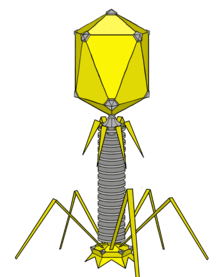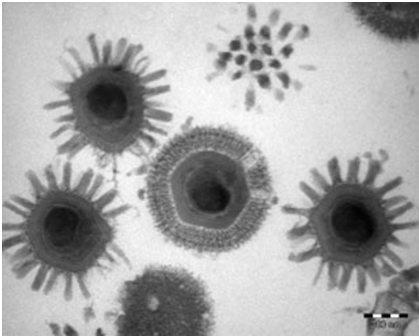Medical virology is simply defined as the study of viruses that are of medical importance i.e. those group or families of viruses that cause disease in humans. Virology therefore is the study of viruses inclusive of those ones that are of medical importance and those that are not harmful but are beneficial in nature. Viruses are non-cellular microorganisms that consist of nucleic acids (either DNA or RNA) which are surrounded by a protein coat. They are particles of nucleic acid molecules either DNA or RNA that are usually surrounded by protein molecules and lipid by lipid membranes in some virions. In other words, viruses are acellular complexes or molecules that consist only of a DNA genome or RNA genome and a protein coat that surrounds its nucleic acid molecule. They are obligate intracellular parasites that only replicate within a living host cell. Viruses are different from the other groups of microorganisms (i.e. bacteria, fungi, protozoa and algae) in several ways. For example, viruses only replicate in particular living cells including cells of other microorganisms, plants, and animals.
Viruses are very small; and they are 100 times smaller than bacteria. They rarely exist or reproduce on their own; and thus viruses cannot survive outside a living cell. And viruses do not contain both DNA and RNA in one organism as their genome but rather, each virion either contains DNA or RNA as its nucleic acid and not both in one organism. A virion (Plural: virions) is a single complete virus particle. Virion, a matured virus is a synonym for virus particle; and it is formed in vivo inside the infected host cell when the invading viral particle takes over the hot cell’s machinery and makes it to produce the components of new viruses that have the same genetic makeup as the parent viral cell. Virion consists mainly of three parts: 1) a nucleic acid genome (DNA or RNA); 2) a capsid or protein coat; and 3) envelop (that surrounds the capsid) which is found in some viruses. The general structure of a virion or viral particle is shown in Figure 1. Another word for capsid is nucleocapsid (a combination of the genome and capsid). Viruses that contain envelops in addition to the usual capsid and genome are generally known as complex (enveloped) viruses while those that contain only the capsid and genome are termed naked (simple) viruses. Scientists or microbiologists that study viruses, and whose area of specialization is on viruses (inclusive of animal, plant and human viruses) are known as virologists.

Capsid (protein coat), a nucleic acid genome (DNA or RNA) and viral envelop are the main components of a viral particle or virion. The capsid or protein coat helps to protect the viral nucleic acid genome from destruction or inactivation by nucleases; and they also facilitate the attachment of viruses to host cells as well as their transfer from one cell to another. The nucleic acid genome contains the genetic information required to produce viral proteins and other molecules necessary for the formation and coupling of new virions. The envelope surrounds the nucleocapsid of some viruses; and they bear specific viral glycoproteins that facilitate viral attachment to host cell(s). As shown in this illustration, the capsid, nucleic acid genome and envelope are the main components of a virus. The nucleocapsid is a combination of the capsid and nucleic acid genome of a virion. While naked viruses lack envelope (an external structure outside the nucleocapsid), naked viruses do not have envelopes.
Viruses are ubiquitous in the universe; and they play various roles ranging from causing epidemics and other viral infectious diseases to their utilization in molecular medicine and pharmaceutical industry for the production of effective vaccines for disease prevention and control. Viruses are distinctive from other microbial cells because they infect other forms of life including prokaryotic and eukaryotic cells. Bacteriophages are viruses that infect bacterial cells or prokaryotes. Such group of viruses that infect bacteria can also be known as phages. Bacteriophages are prevalent in nature; and when they attack bacteria especially a bacterial culture, there is an observable appearance of cleared zones known as plaques that shows the points where the bacterial cells growing in the culture plate have been lysed. It is noteworthy that viruses are not actually cells per se; and this is due in part that they solely depend on their host cell for their own cellular and metabolic activities. However, viruses are not completely regarded as non-living entities because they also exhibit some level of life as other forms of microorganisms. For example, viruses have their own genome (DNA or RNA) like other living organisms. They are capable of autonomous replication with the support of the host cell’s genome which they infect and overpower; and viruses are adaptable to a particular niche or habitat especially those of a living cell that they parasitize in order to assume a living state. Nonetheless, viruses exist as inert cells outside of a living host cells; and they are generally maintained in the laboratory in cell/tissue cultures in vitro and even in egg embryos in vivo.
Viruses possess no functional organelles for the synthesis of their own macromolecules as is obtainable in other forms of life including bacteria and fungi. They are metabolically inactive or inert outside their host cell; and in such scenarios viruses only exist as crystallized forms from which they can easily be transmitted to susceptible cells to cause infection. Since they lack their own independent cellular, metabolic and reproductive prowess, viruses take over the cellular machinery of the cells which they infect and cause same to synthesize products that are beneficial to them (i.e. the invading viral particle). Within the infected host cells, viruses mainly exist as replicating nucleic acid particles (DNA or RNA) coated with protein coat; and they stimulate and overwhelm the host’s metabolic and biosynthesizing machinery to produce the cellular components required for the formation of complete virions. Viruses also exist in the soil, water and air. Viruses like other microbes are ubiquitous and they are found in the air (e.g. influenzae virus), in water and food (e.g. rotavirus); and they can be transmitted to humans through vectors (e.g. yellow fever virus) and through sexual intercourse (e.g. HIV). The study of virology is significant now than ever before owing to the fact that some viral particles or viral diseases are now emerging and re-emerging.
Several outbreaks of viral diseases including but not limited to Ebola haemorrhagic fever and Lassa fever virus have been recently reported in some parts of the world. AIDS, severe acute respiratory syndrome (SARS), influenza virus infection, rabies, respiratory synctial virus (a common cause of pneumonia in infants), human Papilloma virus (causative agent of cervical cancer in women) and hepatitis infection (especially hepatitis B virus, HBV and hepatitis C infection) are some viral infections that still parasitize or harm humanity; and these viral infections amongst others have continued to cause several public health issues across the world, thus putting the public health into jeopardy. These infectious diseases caused by viruses and many other deleterious effects of these unique class of microorganisms (i.e. the viruses) have made the study of viruses more significant than ever before. And it is critical that the microbiologists and other medical and biomedical scientists become well-informed about the basic knowledge of viruses and how these small infectious diseases particles could be properly contained and harnessed for the benefit of all. Only a proper knowledge of viruses can help health care practitioners and the academia to develop ways of containing viral infections especially now that some recent viral disease outbreak (e.g. Ebola virus disease, EVD) has continued to remind us that pathogenic virus or viral infections is still on the horizon.
References
Acheson N.H (2011). Fundamentals of Molecular Virology. Second edition. John Wiley and Sons Limited, West Sussex, United Kingdom.
Alan J. Cann (2005). Principles of Molecular Virology. 4th edition. Elsevier Academic Press, Burlington, MA, USA.
Alberts B, Bray D, Johnson A, Lewis J, Raff M, Roberts K and Walter P (1998). Essential Cell Biology: An Introduction to the Molecular Biology of the Cell. Third edition. Garland Publishing Inc., New York.
Barrett J.T (1998). Microbiology and Immunology Concepts. Philadelphia, PA: Lippincott-Raven Publishers. USA.
Black, J.G. (2008). Microbiology: Principles and Explorations (7th ed.). Hoboken, NJ: J. Wiley & Sons.
Brian W.J Mahy and Mark H.C van Regenmortel (2010). Desk Encyclopedia of Human and Medical Virology. Elsevier Academic Press, San Diego, USA.
Brooks G.F., Butel J.S and Morse S.A (2004). Medical Microbiology, 23rd edition. McGraw Hill Publishers. USA.
Cann A.J (2011). Principles of Molecular Virology. Fifth edition. Academic Press, San Diego, United States.
Carter J and Saunders V (2013). Virology: Principles and Applications. Second edition. Wiley-Blackwell, New Jersey, United States.
Champoux J.J, Neidhardt F.C, Drew W.L and Plorde J.J (2004). Sherris Medical Microbiology: An Introduction to Infectious Diseases. 4th edition. McGraw Hill Companies Inc, USA.
Dimmock N (2015). Introduction to Modern Virology. Seventh edition. Wiley-Blackwell, New Jersey, United States.
Dimmock N.J, Easton A.J and Leppard K.N (2001). Introduction to modern virology. 5th edition. Blackwell Science publishers. Oxford, UK.
Discover more from #1 Microbiology Resource Hub
Subscribe to get the latest posts to your email.


